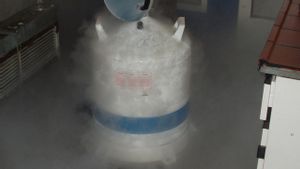JAKARTA - Entrepreneurs producing personal protective equipment (PPE) for hazmat clothing in Boyolali Regency, Central Java, have been flooded with orders as the rate of increase in the number of COVID-19 cases in their area has increased in the past month.
"In fact, PPE for hazmat clothes has become a mandatory item in handling the COVID-19 pandemic, the demand has increased by 50 percent compared to the previous month," said Yuli TB, owner of Gracia Garment Banyudono, who produces hazmat clothes in Boyolali, Central Java, quoted from Antara, Friday, July 23. .
According to Yuli, orders for hazmat clothes have increased since this July. In fact, the production capacity is around 1,200 hazmat suits per day from three production sites, one in Banyudono and two in Sambi with a total number of 60 employees.
"I often refuse orders because I adjust my production capabilities. Orders for hazmat clothes this month reached 1,800 pieces per day, an increase of about 50 percent compared to the previous month. Prices for these hazmat clothes are sold from Rp. 35,000 to Rp. 55,000 per piece," he said.
He admitted that he had been overwhelmed with orders and refused orders because it was beyond production capacity. So far, the production of his hazmat clothes is distributed through distributors in the Solo and surrounding areas, Semarang, Jakarta, and Surabaya. From new distributors distributed to hospitals or volunteers in need.
According to him, there are two types of hazmat clothes to produce. Namely, hazmat clothes for the ring 1 area or in direct contact with COVID-19 patients, such as health workers (Nakes) at hospitals and funeral volunteers. The clothes can only be used once and the material is imported.
The hazmat suit for ring 2 area can be used up to two times. With this breathable microporous hamzat suit, it is waterproof, antiviral, anti-droplet, anti-bacterial, anti-dust, anti-static, not hot and comfortable to use. Special production for handling COVID-19, especially for hospital supplies and volunteers.
He explained that the process of making the hazmat suit started from measuring and cutting the fabric. The special material, then diobras and sewing. After that, the shelling process is carried out or closing the seam cavity using special tape. In order to minimize leakage of hazmat clothes when worn.
The English, Chinese, Japanese, Arabic, and French versions are automatically generated by the AI. So there may still be inaccuracies in translating, please always see Indonesian as our main language. (system supported by DigitalSiber.id)








